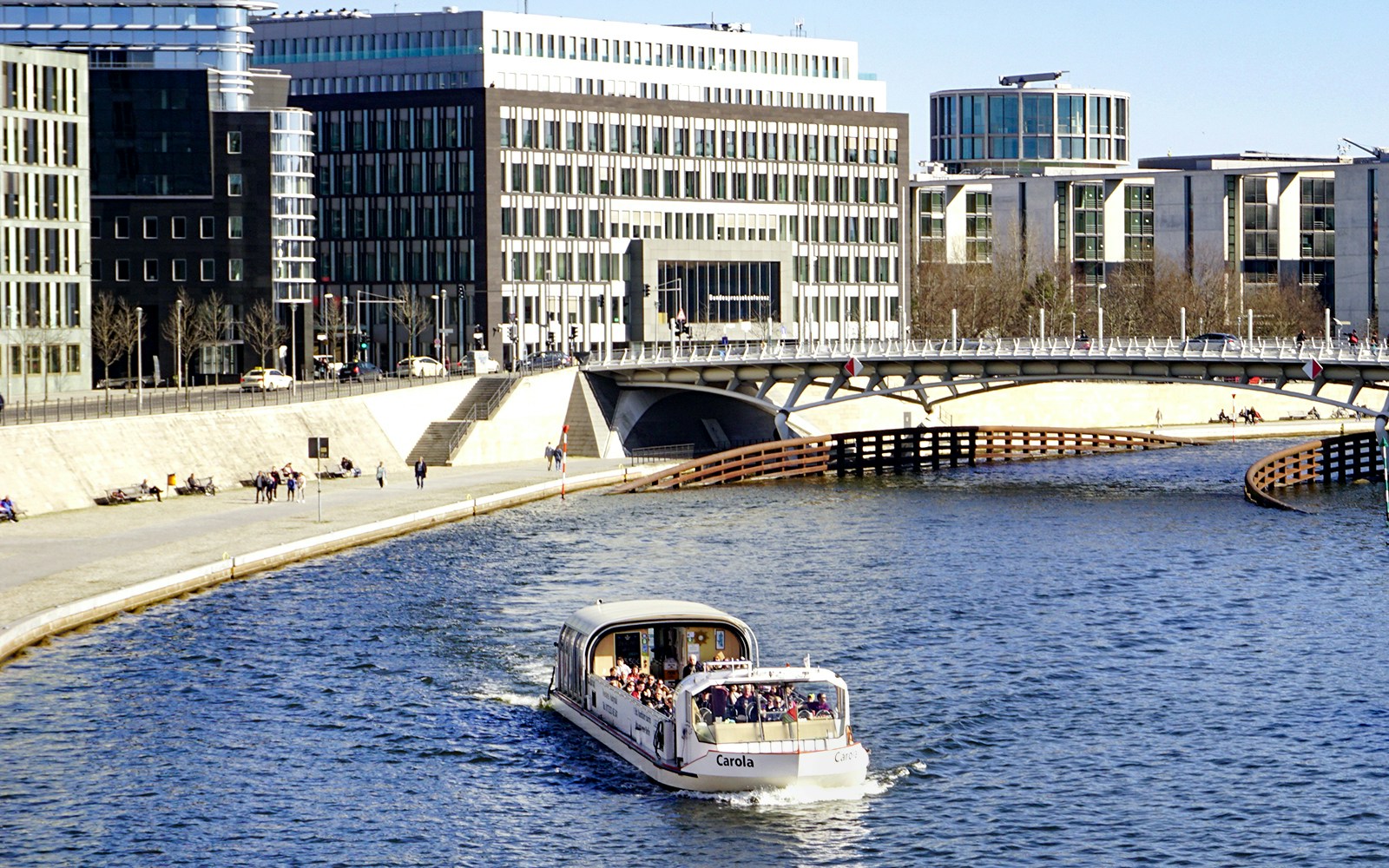Glide past world-famous artworks such as Dmitri Vrubel’s Fraternal Kiss and Birgit Kinder’s Trabant Breaking Through the Wall. These murals, along with dozens of others, trace Berlin’s psychological and political rebirth through bold brushstrokes and protest art.
- Berlin TV Tower
- Friedrichstadt Palast
- Tropical Islands
- Illuseum Berlin
- Sachsenhausen Concentration Camp
- DDR Museum
- Panoramapunkt Berlin
- Big Bus Berlin Hop-on Hop-off Tours
- City Sightseeing Berlin Hop-on Hop-off Tours
- Reichstag Tours
- Berlin Wall Museum
- Berlin Welt Balloon
- Berlin Icebar
- Madame Tussauds
- Samurai Museum Berlin
- LEGOLAND Discovery Centre Berlin
- Fotografiska Tickets
The East Side gallery boat tour | Berlin's artistic legacy where the 'wall' once stood
What makes the East side gallery unique?

Historic significance
Once part of the Berlin Wall's eastern façade, this section became an open-air canvas immediately after the wall fell on November 9, 1989. In 1990, 118 artists from 21 countries came together to commemorate reunification with powerful artworks. Their contributions are still visible today, from the iconic Fraternal Kiss by Dmitri Vrubel to Birgit Kinder’s Trabant Breaking Through the Wall.

Cultural rebirth through art
By 1990, the East Side Gallery officially opened to the public, offering an international dialogue through art. The murals capture the raw political changes of 1989-1990 and are regularly restored to preserve their original impact. In 2018, the gallery was placed under the stewardship of the Stiftung Berliner Mauer (Berlin Wall Foundation), ensuring its preservation as a protected cultural monument.

Creative energy of Friedrichshain
The East Side gallery’s surrounding neighbourhood mirrors the spirit of the gallery itself. Friedrichshain is known for its edgy galleries, independent bookstores, canal-side bars, and cultural events. Across the Oberbaumbrücke, Kreuzberg offers flea markets, food trucks, and street performances. The locality thrives on contrast and creativity, much like the gallery that anchors it.

Accessibility and experiences
The East Side Gallery is open 24/7, free to visit, and fully wheelchair accessible. It’s also most often a starting point for a relaxing Berlin Wall boat cruise, where you’ll see history unfold from a peaceful waterside seat.
What can you see along the East Side gallery boat tour?
East Side gallery murals
Plan your visit to Berlin’s East Side gallery
Most East Side Gallery boat tours depart from Anlegestelle Alte Börse (Old Stock Exchange Pier), located near Museum Island and Monbijoupark | Find on map
- By train:
Take the S-Bahn (S3, S5, S7, or S9) to Hackescher Markt Station. From there, it’s a 2–3 minute walk past Monbijoupark toward the river. The pier is located behind the Alte Börse building, near the Bode Museum. - By bus:
Bus lines 100 and 300 stop at Lustgarten or Spandauer Str./Marienkirche. Walk through Museum Island and head west toward the pier at the rear of Alte Börse.

Weekday vs Weekend
- Weekdays: Especially mid-week mornings offer serene boats, fewer crowds, and calm riverbanks. This is the ideal time for thoughtful mural viewing, relaxed narration, and unobstructed photos.
- Weekends: Expect a livelier scene. Street musicians, gallery-goers, and riverside festivals often energize the route near the East Side Gallery. Boats fill up faster, but the festive atmosphere can enhance the experience.
Peak Season vs Low Season
- Peak Season (May–September): This is the busiest time of year, with tour boats often reaching full capacity, especially on weekends. Expect longer lines at boarding points and lively crowds along the East Side Gallery, Oberbaum Bridge, and nearby riverside cafés.
- Low Season (October–April): Cooler, quieter months bring smaller crowds and a more contemplative mood. Enclosed boats with heating offer cozy views of the murals, and the fading winter light highlights the textured surfaces of the wall.
Book your East Side gallery boat tour
Frequently asked questions about East side gallery Berlin tour
Most tours begin near the Oberbaum Bridge or Ostbahnhof and follow the Spree westward past the East Side Gallery, ending near Museum Island or Berlin Cathedral, depending on the cruise operator.
Typical cruises last 60-90 minutes, though extended routes combining central Berlin landmarks may extend a little longer.
Yes. The Spree runs directly alongside the wall’s river-facing side, offering unobstructed views of the murals, especially iconic ones like the Fraternal Kiss and Trabant Breakthrough.
Many do! Some boats offer live guides, while others provide audio guides in multiple languages. Specialized cruises feature detailed storytelling about the artists and the Berlin Wall’s history.
Yes. You can walk the entire 1.3 km stretch of murals for free 24/7. Many combine a boat ride with a walking tour of the gallery.
Some are, but not all. It’s best to cross check accessibility concerns while booking.
Late afternoon or early evening is ideal. The golden-hour reflections along the Spree create stunning views for photos.
Depending on the route, you may pass the Oberbaum Bridge, Molecule Man, Berlin TV Tower, and historic warehouses in Kreuzberg and Friedrichshain.
On select cruises, yes. Snack bars, beer, or wine may be available. Some evening tours offer drinks included in the ticket price, while others allow you to bring your own refreshments.
The original works remain, but periodic restoration ensures their preservation. Some panels have been repainted by original artists or carefully restored to match the 1990 versions.








